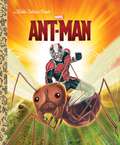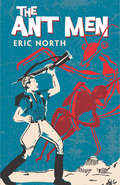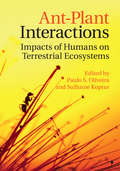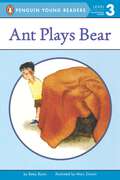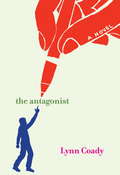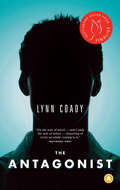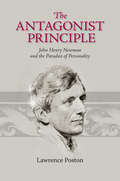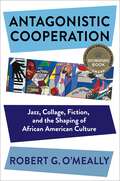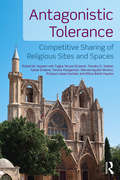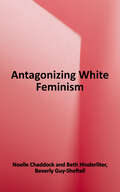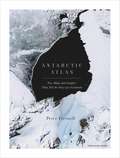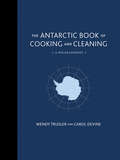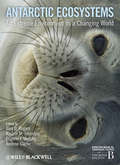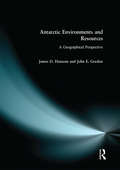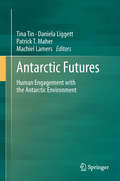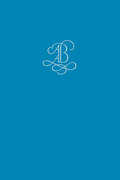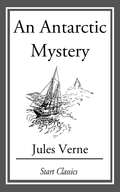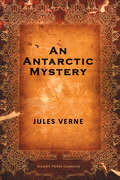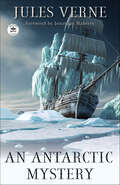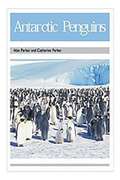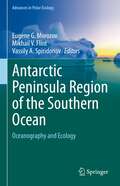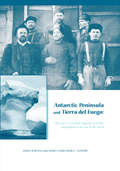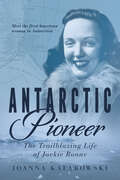- Table View
- List View
Ant-Man (Little Golden Book)
by Billy WrecksMeet Ant-Man, Marvel&’s tiny hero—who packs a big punch! Boys and girls ages 2 to 5 will love this action-packed Little Golden Book featuring Ant-Man and his Marvel friends and villains.
The Ant Men
by Eric North"A well worked fantasy in which suspense and logical scientific conclusions create a sense of reality."—Kirkus Reviews.American geologist Silas Orcutt and his intrepid crew had fully expected to encounter vestiges of prehistoric life in the central Australian desert. But they were hardly prepared for armies of super-intelligent, exceptionally strong insects. A warning shot of formic acid is succeeded by the appearance of six-foot-tall ants that walk upright, communicate by telepathy, and dwell in a sophisticated underground culture.Their advanced society is nonetheless crippled by prejudice—green ants, black ants, and red ants are all sworn foes. In addition to battling each other, the Ant Men are at constant war with their neighbors, a colony of giant mantises. When one of the fossil hunters is taken captive by the Ant Men, Professor Orcutt must lead a dangerous rescue mission. This gripping adventure, reminiscent of tales by H. G. Wells and Jules Verne, builds on a basis of scientific fact to create an authentic background for its pulp-fiction thrills.
Ant-Plant Interactions: Impacts of Humans on Terrestrial Ecosystems (Interspecific Interactions Ser.)
by Oliveira Paulo S. Suzanne KopturAnts are probably the most dominant insect group on Earth, representing ten to fifteen percent of animal biomass in terrestrial ecosystems. Flowering plants, meanwhile, owe their evolutionary success to an array of interspecific interactionsOCosuch as pollination, seed dispersal, and herbivoryOCothat have helped to shape their great diversity. "The Ecology and Evolution of Ant-Plant Interactions" brings together findings from the scientific literature on the coevolution of ants and plants to provide a better understanding of the unparalleled success of these two remarkable groups, of interspecific interactions in general, and ultimately of terrestrial biological communities. "The Ecology and Evolution of Ant-Plant Interactions" synthesizes the dynamics of ant-plant interactions, including the sources of variation in their outcomes. Victor Rico-Gray and Paulo S. Oliveira capture both the emerging appreciation of the importance of these interactions within ecosystems and the developing approaches that place studies of these interactions into a broader ecological and evolutionary context. The collaboration of two internationally renowned scientists, "The Ecology and Evolution of Ant-Plant Interactions" will become a standard reference for understanding the complex interactions between these two taxa. "
Ant Plays Bear (Penguin Young Readers, Level 3)
by Betsy ByarsIn this delightful follow-up to My Brother, Ant, Anthony comes face to face with a growling bear, pretends to be a dog, and hears a giant tapping on the window. These enchanting stories capture the relationship between Ant and his brother with warmth and humor.
The Antagonist
by Lynn CoadyA piercing epistolary novel, The Antagonist explores, with wit and compassion, how the impressions of others shape, pervert, and flummox both our perceptions of ourselves and our very nature. Gordon Rankin Jr., aka "Rank," thinks of himself as "King Midas in reverse"--and indeed misfortune seems to follow him at every turn. Against his will and his nature, he has long been considered--given his enormous size and strength--a goon and enforcer by his classmates, by his hockey coaches, and, not least, by his "tiny, angry" father. He gamely lives up to their expectations, until a vicious twist of fate forces him to flee underground. Now pushing forty, he discovers that an old, trusted friend from his college days has published a novel that borrows freely from the traumatic events of Rank's own life. Outraged by this betrayal and feeling cruelly misrepresented, he bashes out his own version of his story in a barrage of e-mails to the novelist that range from funny to furious to heartbreaking.With The Antagonist, Lynn Coady demonstrates all of the gifts that have made her one of Canada's most respected young writers. Here she gives us an astonishing story of sons and fathers and mothers, of the rewards and betrayals of male friendship, and a large-spirited, hilarious, and exhilarating portrait of a man tearing his life apart in order to put himself back together.
The Antagonist
by Lynn CoadyAgainst his will and his nature, the hulking Gordon Rankin ("Rank") is cast as an enforcer, a goon -- by his classmates, his hockey coaches, and especially his own "tiny, angry" father, Gordon Senior. Rank gamely lives up to his role -- until tragedy strikes, using Rank as its blunt instrument. Escaping the only way he can, Rank disappears. But almost twenty years later he discovers that an old, trusted friend -- the only person to whom he has ever confessed his sins -- has published a novel mirroring Rank's life. The betrayal cuts to the deepest heart of him, and Rank will finally have to confront the tragic true story from which he's spent his whole life running away. With the deep compassion, deft touch, and irreverent humour that have made her one of Canada's best-loved novelists, Lynn Coady delves deeply into the ways we sanction and stoke male violence, giving us a large-hearted, often hilarious portrait of a man tearing himself apart in order to put himself back together.
The Antagonist Principle: John Henry Newman and the Paradox of Personality (Victorian Literature and Culture Series)
by Lawrence PostonThe Antagonist Principle is a critical examination of the works and sometimes controversial public career of John Henry Newman (1801-1890), first as an Anglican and then as Victorian England's most famous convert to Roman Catholicism at a time when such a conversion was not only a minority choice but in some quarters a deeply offensive one. Lawrence Poston adopts the idea of personality as his theme, not only in the modern sense of warring elements in one's own temperament and relationships with others but also in a theological sense as a central premise of orthodox Trinitarian Christian doctrine. The principle of "antagonism," in the sense of opposition, Poston argues, activated Newman's imagination while simultaneously setting limits to his achievement, both as a spiritual leader and as a writer. The author draws on a wide variety of biographical, historical, literary, and theological scholarship to provide an "ethical" reading of Newman's texts that seeks to offer a humane and complex portrait. Neither a biography nor a revelation of a life, this textual study of Newman's development as a theologian in his published works and private correspondence attempts to resituate him as one of the most combative of the Victorian seekers. Though his spiritual quest took place on the far right of the religious spectrum in Victorian England, it nonetheless allied him with a number of other prominent figures of his generation as distinct from each other as Thomas Carlyle, John Stuart Mill, and Walter Pater. Avoiding both hagiography and iconoclasm, Poston aims to "see Newman whole."
Antagonistic Cooperation: Jazz, Collage, Fiction, and the Shaping of African American Culture (Leonard Hastings Schoff Lectures)
by Robert O'MeallyRalph Ellison famously characterized ensemble jazz improvisation as “antagonistic cooperation.” Both collaborative and competitive, musicians play with and against one another to create art and community. In Antagonistic Cooperation, Robert G. O’Meally shows how this idea runs throughout twentieth-century African American culture to provide a new history of Black creativity and aesthetics.From the collages of Romare Bearden and paintings of Jean-Michel Basquiat to the fiction of Ralph Ellison and Toni Morrison to the music of Louis Armstrong and Duke Ellington, O’Meally explores how the worlds of African American jazz, art, and literature have informed one another. He argues that these artists drew on the improvisatory nature of jazz and the techniques of collage not as a way to depict a fractured or broken sense of Blackness but rather to see the Black self as beautifully layered and complex. They developed a shared set of methods and motives driven by the belief that art must involve a sense of community. O’Meally’s readings of these artists and their work emphasize how they have not only contributed to understanding of Black history and culture but also provided hope for fulfilling the broken promises of American democracy.
Antagonistic Tolerance: Competitive Sharing of Religious Sites and Spaces
by Devika Rangachari Timothy D. Walker Robert M. Hayden Aykan Erdemir Tuğba Tanyeri-Erdemir Manuel Aguilar-Moreno Enrique López-Hurtado Milica Bakić-HaydenAntagonistic Tolerance examines patterns of coexistence and conflict amongst members of different religious communities, using multidisciplinary research to analyze groups who have peacefully intermingled for generations, and who may have developed aspects of syncretism in their religious practices, and yet have turned violently on each other. Such communities define themselves as separate peoples, with different and often competing interests, yet their interaction is usually peaceable provided the dominance of one group is clear. The key indicator of dominance is control over central religious sites, which may be tacitly shared for long periods, but later contested and even converted as dominance changes. By focusing on these shared and contested sites, this volume allows for a wider understanding of relations between these communities. Using a range of ethnographic, historical and archaeological data from the Balkans, India, Mexico, Peru, Portugal and Turkey, Antagonistic Tolerance develops a comparative model of the competitive sharing and transformation of religious sites. These studies are not considered as isolated cases, but are instead woven into a unified analytical framework which explains how long-term peaceful interactions between religious communities can turn conflictual and even result in ethnic cleansing.
Antagonists in the Church: How to Identify and Deal With Destructive Conflict
by Kenneth C. HaugkExcellent book on dealing with conflict in the church.
Antagonizing White Feminism: Intersectionality's Critique of Women's Studies and the Academy (Feminist Strategies: Flexible Theories And Resilient Practices Ser.)
by Noelle Chaddock Sara Salem Beverly Guy-Sheftall Beth Hinderliter Piya Chatterjee Timothy W. Gerken Laneshia Conner Pablo Ariel Scharagrodsky Magalí Pérez Riedel Vanessa Drew-Branch Sonyia RichardsonThis text pushes back against the exclusive scholarship and discourse coming out of women-centered spaces and projects, which throw up barriers by narrowly defining who can participate. Vehement resistance to using inclusive language and renaming scholarly spaces like Women's Studies and Critical Feminism expresses itself in concerns that women are still oppressed and thus women-only spaces must be maintained. But who is a woman? What are the characteristics of a woman's lived experience? Do affinity and a history of oppression justify exclusion? This book shows how intersectional feminism is often underperformed and appropriated as a "woke" vocabulary by elite women who are unwilling to do the necessary emotional work around their privilege. As Trans Women, Femmes, Women of Color, Queer Women, Gender Variant, and Gender Non-Conforming scholars emerge, the heteronormative, cisgender, colonial idea of women and the feminine is rapidly under attack. The contributors believe that to engage in the necessary conversations about the oppressed performing oppression is to disrupt the exclusionary basis of monolithic understandings of the feminine. Only then can we advance the coalition needed to forge a multiracial, multicultural, queer-led, anti-imperialist feminism.
Antaral: End-Century Meditations
by K. SatchidanandanThe author looks back at the passing century / millennium and also ponders over the coming one. The explorations cut across diverse disciplines like history, philosophy, literature, science, religion and social and political thought.
Antarctic Atlas: New Maps and Graphics That Tell the Story of A Continent
by Peter FretwellA FINANCIAL TIMES BOOK OF THE YEAR 2020SHORTLISTED FOR THE ESTWA AWARD FOR ILLUSTRATED TRAVEL BOOK OF THE YEAR 2022One of the least-known places on the planet, the only continent on earth with no indigenous population, Antarctica is a world apart. From a leading cartographer with the British Antarctic Survey, this new collection of maps and data reveals Antarctica as we have never seen it before.This is not just a book of traditional maps. It measures everything from the thickness of ice beneath our feet to the direction of ice flows. It maps volcanic lakes, mountain ranges the size of the Alps and gorges longer than the Grand Canyon, all hidden beneath the ice. It shows us how air bubbles trapped in ice tell us what the earth's atmosphere was like 750,000 years ago, proving the effects of greenhouse gases. Colonies of emperor penguins abound around the coastline, and the journeys of individual seals around the continent and down to the sea bed in search of food have been intricately tracked and mapped. Twenty-nine nations have research stations in Antarctica and their unique architecture is laid out here, along with the challenges of surviving in Antarctica'sunforgiving environment.Antarctica is also the frontier of our fight against climate change. If its ice melts, it will swamp almost every coastal city in the world. Antarctic Atlas illustrates the harsh beauty and magic of this mysterious continent, and shows how, far from being abstract, it has direct relevance to us all.
The Antarctic Book of Cooking and Cleaning: A Polar Journey
by Wendy Trusler Carol DevineThis stunning chronicle of the first civilian Antarctic clean-up project, with contemporary and historic anecdotes and photographs, journal entries, and more than forty delicious recipes, is an intricately woven ode to the last wilderness.With more than 130 full-color photographs
Antarctic Ecosystems: An Extreme Environment in a Changing World
by Alex D. Rogers Nadine M. Johnston Eugene J. Murphy Andrew ClarkeSince its discovery Antarctica has held a deep fascination for biologists. Extreme environmental conditions, seasonality and isolation have lead to some of the most striking examples of natural selection and adaptation on Earth. Paradoxically, some of these adaptations may pose constraints on the ability of the Antarctic biota to respond to climate change. Parts of Antarctica are showing some of the largest changes in temperature and other environmental conditions in the world. In this volume, published in association with the Royal Society, leading polar scientists present a synthesis of the latest research on the biological systems in Antarctica, covering organisms from microbes to vertebrate higher predators. This book comes at a time when new technologies and approaches allow the implications of climate change and other direct human impacts on Antarctica to be viewed at a range of scales; across entire regions, whole ecosystems and down to the level of species and variation within their genomes. Chapters address both Antarctic terrestrial and marine ecosystems, and the scientific and management challenges of the future are explored.
Antarctic Environments and Resources: A Geographical Perspective
by J.D. Hansom John GordonAntarctica is no longer a 'pole apart'. From a scientific perspective, the Antarctic ice sheet, ocean and climate systems are intimately linked with the global climate and are now seen to be of international significance for understanding climate change. From an economic perspective, the Antarctic is perceived to have great potential as a source of marine resources although the extent of speculated mineral and hydrocarbon resources is unknown. From a conservation perspective, the continent of Antarctica represents the ideal image of unspoiled wilderness.Antarctic Environments and Resources is an accessible and timely new geography of the Antarctic which examines the differing and sometimes conflicting interests in the great southern continent, the Southern Ocean and the subantarctic islands against a background of the physical and natural systems of the region and their interactions. It charts the development of human involvement in the area, focusing on the exploitation of resources from early sealing to modern fisheries, tourism and science, and it assesses the consequent impacts on the natural environment. The text also reviews the emerging framework for future environmental management developed under the Antarctic Treaty System.This is an ideal text for undergraduates studying glacial geomorphology, environmental management, polar regions and the Antarctic.
Antarctic Futures: Human Engagement with the Antarctic Environment
by Machiel Lamers Tina Tin Daniela Liggett Patrick T MaherAt the beginning of the 21st century, Antarctica is poised at the edge of a warmer and busier world. Leading Antarctic researchers examine the needs and challenges of Antarctic environmental management today and tomorrow. Through: (i) investigating the impacts of human activities on specific ecosystems and species, (ii) examining existing environmental management and monitoring practices in place in various regions and (iii) interrogating stakeholders, they address the following questions: What future will Business-As-Usual bring to the Antarctic environment? Will a Business-As-Usual future be compatible with the objectives set out under the Antarctic Treaty, especially its Protocol on Environmental Protection? What actions are necessary to bring about alternative futures for the next 50 years? This volume is an outcome of the International Polar Year (2007-2009) Oslo Science Conference (8-12, June, 2010).
Antarctic Glacial History and World Palaeoenvironments
by E.M. van Zinderen BakkerThis book, based on the proceedings of third symposium held on 17th August 1977 during the Xth INQUA Congress at Birmingham, UK, focuses on the influence the Antarctic glaciation had on world palaeoenvironments.
An Antarctic Mystery
by Jules VerneIn the year 1839, Mr. Jeorling, whose geological and mineralogical research have led him to the Kerguelen sub-Antarctic archipelago in the Indian Ocean, sets sail on the "Halbrane", whose captain Len Guy is obsessed with Edgar Allan Poe's novel "The Narrative of Arthur Gordon Pym". --- In that narrative, Poe recounts the adventures of Len Guy's brother William Guy who as captain of the "Jane" was persuaded by Arthur Gordon Pym to direct an expedition to the Antarctic. The "Jane" vanished on this voyage, though Pym was still able to pass along his diary to Edgar Allen Poe. --- Increasingly persuaded of the truthfulness of the tale, Mr. Jeorling encourages Captain Len Guy to pursue his brother - whom they believe may still be alive - into the Antarctic. --- Aside from the natural perils of the ocean, they must also face down a mutiny of the sailors on the "Halbrane".
An Antarctic Mystery
by Jules VerneAn Antarctic Mystery; or, The Sphinx of the Ice Fields, was published first in 1897 as a response to Edgar Allan Poe's 1838 novel The Narrative of Arthur Gordon Pym of Nantucket. It is an adventure story following the journey of of an unnamed narrator through the Kerguelen Islands in the Indian Ocean aboard the ship, the Halbrane.
An Antarctic Mystery
by Jules Verneules Verne’s sequel to Poe’s classic The Narrative of Arthur Gordon Pym of Nantucket. ??? ?A captain seeking a lost brother. ??? ?A sailor obsessed with redemption as he hides a dark secret. ??? ?A wealthy onlooker intrigued by possibility. ??? ?Brought together by coincidence, they embark on a journey into the uncharted waters of the Antarctic. ??? ?Jules Verne weaves a story of exploration, adventure, and mystery in this exciting tale. An Antarctic Mystery is the unauthorized sequel to Edgar Allan Poe’s The Narrative of Arthur Gordon Pym of Nantucket and brings closure to Poe’s cliffhanger ending. ??? ?Journey through the Antarctic as Verne reveals the shocking conclusion to one of his favorite childhood tales.
Antarctic Penguins (Rigby PM Collection Silver (Levels 23-24), Fountas & Pinnell Select Collections Grade 3 Level O)
by Alan Parker Catherine ParkerDiscusses Emperor and Adélie penguins, their feeding habits and reproduction. In addition the dangers to their life are outlined including the difficulties of survival in Antarctica and their vulnerability to preditors.
Antarctic Peninsula Region of the Southern Ocean: Oceanography and Ecology (Advances in Polar Ecology #6)
by Eugene G. Morozov Mikhail V. Flint Vassily A. SpiridonovThe book is based on results from the Russian expedition in the region of the Antarctic Peninsula and Powell Basin in the northern part of the Weddell Sea, as well as on the review of earlier research in the region. The main goal of the research was to collect the newest data and study the physical properties and ecology of this key region of the Southern Ocean. Data analysis is supplemented with numerical modeling of the atmosphere-ocean interaction and circulation in the adjacent region, including research on rogue waves. The focus of the study was the Antarctic Circumpolar Current, currents and water properties in the Bransfield Strait and Antarctic Sound, properties of seawater, currents, ecosystem and biological communities in the Powell Basin of the northwestern Weddell Sea, and their variations. An attempt is made to reveal the role of various components of the Antarctic environment in the formation of biological productivity and maintenance of the Antarctic krill population. This is especially important as in the last decades the Antarctic environment has experienced significant changes related to the global climatic trends.
Antarctic Peninsula & Tierra del Fuego: Proceedings of "Otto Nordensjold's Antarctic Expedition of 1901-1903 and Swedish Scientists in Patagonia: A Symposium", Buenos Aires, Argentina, March 2-7, 2003
by Jorge Rabassa María Laura BorlaThis symposium, held in Argentina in March 2003, commemorates Otto Nordenskjold's 1901 expedition, and pays tribute to the Swedish and Argentinian explorers who took on the challenge of early fieldwork in Patagonia and Antarctica. This theme is extended to include recent fieldwork in the natural sciences in the Archipelago of Tierra del Fuego, the
Antarctic Pioneer: The Trailblazing Life of Jackie Ronne
by Joanna KafarowskiJackie Ronne reclaims her rightful place in polar history as the first American woman in Antarctica. Jackie was an ordinary American woman whose life changed after a blind date with rugged Antarctic explorer Finn Ronne. After marrying, they began planning the 1946–1948 Ronne Antarctic Research Expedition. Her participation was not welcomed by the expedition team of red-blooded males eager to prove themselves in the frozen, hostile environment of Antarctica.On March 12, 1947, Jackie Ronne became the first American woman in Antarctica and, months later, one of the first women to overwinter there.The Ronne Antarctic Research Expedition secured its place in Antarctic history, but its scientific contributions have been overshadowed by conflicts and the dangerous accidents that occurred. Jackie dedicated her life to Antarctica: she promoted the achievements of the expedition and was a pioneer in polar tourism and an early supporter of the Antarctic Treaty. In doing so, she helped shape the narrative of twentieth-century Antarctic exploration.
